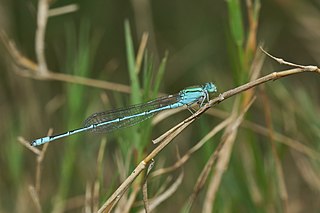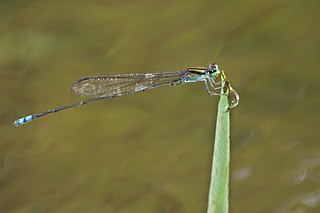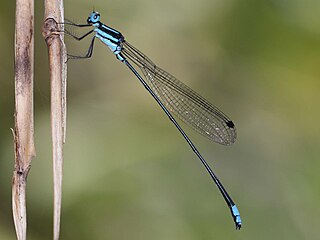
The blue riverdamsel, Pseudagrion microcephalum is a common species of damselfly in the family Coenagrionidae. It is also known as the blue sprite and blue grass dart.

Esme longistyla is damselfly in the family Platycnemididae. It is commonly known as the Nilgiri bambootail. It is endemic to Western Ghats in India.

Lestes elatus is a species of damselfly in the family Lestidae, the spreadwings. It is known commonly as the emerald spreadwing. It is native to India, Thailand and Sri Lanka.

Aciagrion occidentale, green striped slender dartlet, is a species of damselfly in the family Coenagrionidae. It is found in India, Sri Lanka, Maldives, Vietnam and Thailand.

Amphiallagma parvum, little blue or azure dartlet, is a species of damselfly in the family Coenagrionidae. This species can be found in many South Asian countries including India, Sri Lanka, Myanmar, Thailand, Nepal, and probably in Bangladesh.

Pseudagrion malabaricum, Malabar sprite, jungle grass dart, is a species of damselfly in the family Coenagrionidae. It is found in India, Sri Lanka, and Myanmar.

Pseudagrion rubriceps, saffron-faced blue dart, is a species of damselfly in the family Coenagrionidae. It is found in many tropical Asian countries.

Pseudagrion decorum, elegant sprite or three striped blue dart, is a species of damselfly in the family Coenagrionidae. It is found in many tropical Asian countries.

Calocypha laidlawi, or myristica sapphire, is a rare species of damselfly belonging to the family Chlorocyphidae. It is found only from Karnataka and Kerala in South India.

Paracercion calamorum, the dusky lilly-squatter, is a species of damselfly in the family Coenagrionidae. It has a range that extends from southern far-eastern Russia to Japan, and to India and Indonesia. The nominate subspecies P. c. calamorum is known from central and eastern China, Korea and Japan. The subspecies P. c. dyeri occurs in southern China, Hong Kong, Taiwan, Indonesia, India, Nepal, and Thailand.

Pseudagrion indicum, yellow-striped blue dart or yellow-striped dart, is a species of damselfly in the family Coenagrionidae. It is found only in Western Ghats of India.

Caconeura ramburi is a damselfly species in the family Platycnemididae. It is commonly known as the Coorg Bambootail or Indian blue bambootail. It is endemic to Western Ghats.

Caconeura gomphoides is a damselfly species in the family Platycnemididae. It is endemic to high altitude peat bogs and grassy uplands in Nilgiris.

Phylloneura westermanni, Myristica bambootail is a damselfly species in the family Platycnemididae. It is endemic to Myristica swamps of Western Ghats in India. The habitat is restricted to a few localities in Karnataka, Kerala and Tamil Nadu.

Esme mudiensis is a damselfly in the family Platycnemididae. It is commonly known as the Travancore bambootail. It is endemic to the Western Ghats in India, particularly south of Palakkad Gap.

Esme cyaneovittata is damselfly in the family Platycnemididae. It is endemic to Western Ghats in India, south of Palakkad Gap.

Melanoneura bilineata is damselfly in the family Platycnemididae. It is endemic to Western Ghats in India, restricted to Kodagu and Wayanad districts.

Protosticta sanguinostigma, the red spot reedtail, is a damselfly species in the family Platystictidae. It is endemic to Western Ghats in India. It is known to occur only in a few localities.

Protosticta hearseyi, the little reedtail, is a damselfly species in the family Platystictidae. It is endemic to Western Ghats in India.
Protosticta antelopoides, the spiny reedtail, is a damselfly species in the family Platystictidae. It is endemic to Western Ghats in India.




















